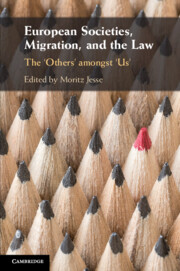Book contents
- European Societies, Migration, and the Law
- European Societies, Migration, and the Law
- Copyright page
- Dedication
- Contents
- Figures and Tables
- Contributors
- Preface
- Acknowledgements
- Abbreviations
- 1 European Societies, Migration, and the Law
- Part I Making the ‘Other’ – The Construction of ‘Otherness’
- Part II The Operation of Legal ‘Othering’ and the National–Foreigner Dichotomy in the EU
- Part III After the Arrival of the ‘Others’ – Reactions to the ‘Refugee Crisis’ of 2015
- Part IV ‘Othering’ in the EU
- 14 When a Country Is Not a Home
- 15 The ‘Market Insider’
- 16 Inclusion and Exclusion of Migrant Workers in the EU
- Part V European Societies, ‘Otherness’, Migration, and the Law
- Bibliography
- Index
16 - Inclusion and Exclusion of Migrant Workers in the EU
from Part IV - ‘Othering’ in the EU
Published online by Cambridge University Press: 13 November 2020
- European Societies, Migration, and the Law
- European Societies, Migration, and the Law
- Copyright page
- Dedication
- Contents
- Figures and Tables
- Contributors
- Preface
- Acknowledgements
- Abbreviations
- 1 European Societies, Migration, and the Law
- Part I Making the ‘Other’ – The Construction of ‘Otherness’
- Part II The Operation of Legal ‘Othering’ and the National–Foreigner Dichotomy in the EU
- Part III After the Arrival of the ‘Others’ – Reactions to the ‘Refugee Crisis’ of 2015
- Part IV ‘Othering’ in the EU
- 14 When a Country Is Not a Home
- 15 The ‘Market Insider’
- 16 Inclusion and Exclusion of Migrant Workers in the EU
- Part V European Societies, ‘Otherness’, Migration, and the Law
- Bibliography
- Index
Summary
The market logic of the internal market has historically meant that EU citizens engaged in economic activity in a host-Member State obtain a secure form of lawful residence and far-reaching rights. For economically inactive citizens there is a less secure status in terms of residence, as well as more limited and conditional rights. The traditional case law of the Court of Justice of the EU has had the effect of protecting EU migrant workers in lower-paid employment. However, in the light of recent legal developments, some have suggested that this traditional position is being undermined. This chapter assesses the extent to which the EU legal system excludes those EU migrant workers on the fringes of economic activity. It begins by assessing how the ‘working proletariat’ should be understood in the 21st Century. It then analyses the development of the law of freedom of movement for workers and EU citizenship. Concretely, it claims that the introduction of Union citizenship, rather than offering a safety net for EU migrants regardless of their legal status, in some cases actually resulted in less protection than previously for EU migrant workers. Finally, it analyses the legal and wider implications of the exclusionary system.
Keywords
- Type
- Chapter
- Information
- European Societies, Migration, and the LawThe ‘Others' amongst ‘Us', pp. 301 - 320Publisher: Cambridge University PressPrint publication year: 2020



